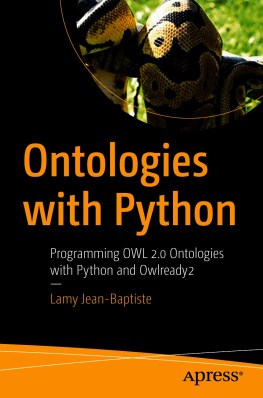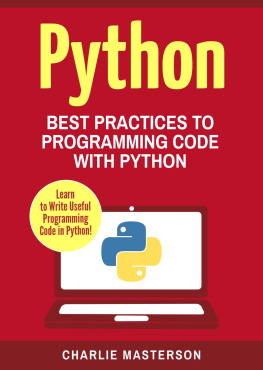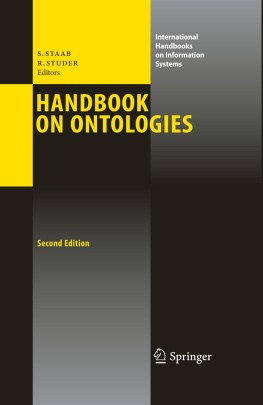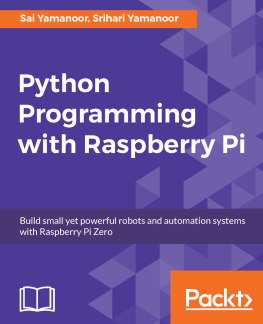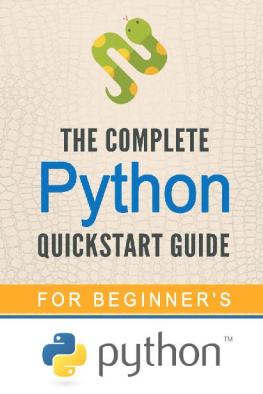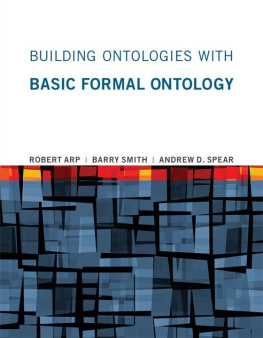Lamy Jean-Baptiste
Universit Sorbonne Paris Nord, LIMICS, Sorbonne Universit INSERM, UMR 1142, Bobigny, France
Any source code or other supplementary material referenced by the author in this book is available to readers on GitHub via the books product page, located at www.apress.com/978-1-4842-6551-2 . For more detailed information, please visit http://www.apress.com/source-code .
ISBN 978-1-4842-6551-2 e-ISBN 978-1-4842-6552-9
https://doi.org/10.1007/978-1-4842-6552-9
Lamy Jean-Baptiste 2021
Standard Apress
Trademarked names, logos, and images may appear in this book. Rather than use a trademark symbol with every occurrence of a trademarked name, logo, or image we use the names, logos, and images only in an editorial fashion and to the benefit of the trademark owner, with no intention of infringement of the trademark. The use in this publication of trade names, trademarks, service marks, and similar terms, even if they are not identified as such, is not to be taken as an expression of opinion as to whether or not they are subject to proprietary rights.
The publisher, the authors and the editors are safe to assume that the advice and information in this book are believed to be true and accurate at the date of publication. Neither the publisher nor the authors or the editors give a warranty, express or implied, with respect to the material contained herein or for any errors or omissions that may have been made. The publisher remains neutral with regard to jurisdictional claims in published maps and institutional affiliations.
Distributed to the book trade worldwide by Springer Science+Business Media New York, 1 New York Plaza, Suite 4600, New York, NY 10004-1562, USA. Phone 1-800-SPRINGER, fax (201) 348-4505, e-mail orders-ny@springer-sbm.com, or visit www.springeronline.com. Apress Media, LLC is a California LLC and the sole member (owner) is Springer Science + Business Media Finance Inc (SSBM Finance Inc). SSBM Finance Inc is a Delaware corporation.
Acknowledgments
I would like to thank Moushin Gaouar, Appoh Kouame, and Adrien Basse for being among the first to test Owlready, as well as my friends and/or colleagues Rosy Tsopra, Gaoussou Camara, Antoine Gellman, Patricia Nadjar, Antoine Saab, David Perlmutter, Arnaud Rosier, Karima Sedki, Fadi Badra, Jordon Ritchie, Brandon Welch, Lina Soualmia, and Marie-Christine Jaulent for discussions on ontologies, long or short, and sometimes even before the existence of Owlready.
I also thank the ANSM (Agence Nationale de Scurit du Mdicament et des produits de sant, French drug agency) for having funded the VIIIP project (Integrated Visualization of Information on Therapeutic Innovation), during which Owlready was born (at the time under the name Ontopy).
Finally, I thank all members of the Owlready forum on Nabble ( http://owlready.8326.n8.nabble.com/ ) for their requests and their advice, which greatly influenced the content of this book.
About the Author
Lamy Jean-Baptiste
is a senior lecturer at Sorbonne Paris Nord University and a member of the LIMICS, a research lab focused on biomedical informatics. He is also the developer of the Owlready2 Python module that allows access to OWL ontologies. He has developed many research prototypes, and one of them (VCM iconic medical language) has been patented in the United States, with three licenses sold to industrial partners.
Jean-Baptiste speaks regularly at artificial intelligence and medical informatics conferences, has written over 50 journal papers, and is a moderator on the Owlready forum on Nabbles. He was awarded the best paper award at MEDINFO 2019, the largest international conference in medical informatics.
About the Technical Reviewers
Tee Diang
is a software engineer with a strong background in Python and Java. She studied computer science with a focus on artificial intelligence, game development, and system engineeringfrom CPUs and the Internet itself to Pythons rich history of libraries and standards to DevOps cloud infrastructure. Her most recent projects exemplify her ability to captivate users with her work.
Jeff
grew up in the San Francisco Bay Area, surrounded by the burgeoning technology scene. Jeff has 10 years of experience working on development. He currently works at Apple. Jeff writes clean, consistent code. Outside of the work, he enjoys working on open source projects like broaden.io to help people to broaden their skills, broaden their education, and broaden their knowledge.
Lamy Jean-Baptiste 2021
L. Jean-Baptiste Ontologies with Python https://doi.org/10.1007/978-1-4842-6552-9_1
1. Introduction
Lamy Jean-Baptiste
(1)
Universit Sorbonne Paris Nord, LIMICS, Sorbonne Universit INSERM, UMR 1142, Bobigny, France
For the past ten years, formal ontologies have become widely used in computer science to structure data and knowledge. In parallel, the Python programming language has become more and more widespread in teaching, business, and research. However, until recently, there were very few tools and resources dedicated to the use of ontologies in Python. In fact, most books or tutorials on ontologies are quite theoretical and do not address programming, or they are limited to more complex languages like Java.
This problem is particularly important in the biomedical field, where ontologies and Python are widely used. Too often, in my daily life as a teacher and researcher in medical informatics at Sorbonne Paris Nord University, I have seen students and engineers build ontologies that have subsequently not been used. The files remained on a USB key, because it was not easy to integrate ontologies with existing software.
This book exists to fill this gap. It shows how to use Python to easily access ontologies and publish them as dynamic websites, to build new ontologies, perform automatic reasoning, link entities to medical terminologies, or do some research in DBpedia using Owlready, a Python module I develop since 2013 for ontology-oriented programming. And, in this book, we will not be afraid to implement ontology-based programs: you will see more source codes than mathematical formulas!
1.1 Who is this book for?
This book is for anyone who wants to manipulate and build ontologies in Python, or to discover the world of ontologies from a practical point of view, and especially for computer scientists and semantic web application developers, bioinformaticians, scientists in the field of artificial intelligence, students in these disciplines or simply for the curious!

